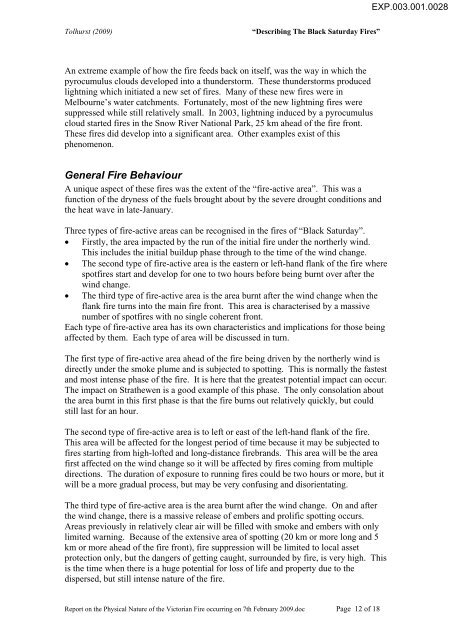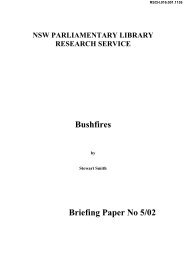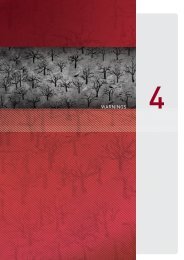Report on the Physical Nature of the Victorian Fires occurring on 7th ...
Report on the Physical Nature of the Victorian Fires occurring on 7th ...
Report on the Physical Nature of the Victorian Fires occurring on 7th ...
Create successful ePaper yourself
Turn your PDF publications into a flip-book with our unique Google optimized e-Paper software.
EXP.003.001.0028<br />
Tolhurst (2009)<br />
“Describing The Black Saturday <strong>Fires</strong>”<br />
An extreme example <strong>of</strong> how <strong>the</strong> fire feeds back <strong>on</strong> itself, was <strong>the</strong> way in which <strong>the</strong><br />
pyrocumulus clouds developed into a thunderstorm. These thunderstorms produced<br />
lightning which initiated a new set <strong>of</strong> fires. Many <strong>of</strong> <strong>the</strong>se new fires were in<br />
Melbourne’s water catchments. Fortunately, most <strong>of</strong> <strong>the</strong> new lightning fires were<br />
suppressed while still relatively small. In 2003, lightning induced by a pyrocumulus<br />
cloud started fires in <strong>the</strong> Snow River Nati<strong>on</strong>al Park, 25 km ahead <strong>of</strong> <strong>the</strong> fire fr<strong>on</strong>t.<br />
These fires did develop into a significant area. O<strong>the</strong>r examples exist <strong>of</strong> this<br />
phenomen<strong>on</strong>.<br />
General Fire Behaviour<br />
A unique aspect <strong>of</strong> <strong>the</strong>se fires was <strong>the</strong> extent <strong>of</strong> <strong>the</strong> “fire-active area”. This was a<br />
functi<strong>on</strong> <strong>of</strong> <strong>the</strong> dryness <strong>of</strong> <strong>the</strong> fuels brought about by <strong>the</strong> severe drought c<strong>on</strong>diti<strong>on</strong>s and<br />
<strong>the</strong> heat wave in late-January.<br />
Three types <strong>of</strong> fire-active areas can be recognised in <strong>the</strong> fires <strong>of</strong> “Black Saturday”.<br />
• Firstly, <strong>the</strong> area impacted by <strong>the</strong> run <strong>of</strong> <strong>the</strong> initial fire under <strong>the</strong> nor<strong>the</strong>rly wind.<br />
This includes <strong>the</strong> initial buildup phase through to <strong>the</strong> time <strong>of</strong> <strong>the</strong> wind change.<br />
• The sec<strong>on</strong>d type <strong>of</strong> fire-active area is <strong>the</strong> eastern or left-hand flank <strong>of</strong> <strong>the</strong> fire where<br />
spotfires start and develop for <strong>on</strong>e to two hours before being burnt over after <strong>the</strong><br />
wind change.<br />
• The third type <strong>of</strong> fire-active area is <strong>the</strong> area burnt after <strong>the</strong> wind change when <strong>the</strong><br />
flank fire turns into <strong>the</strong> main fire fr<strong>on</strong>t. This area is characterised by a massive<br />
number <strong>of</strong> spotfires with no single coherent fr<strong>on</strong>t.<br />
Each type <strong>of</strong> fire-active area has its own characteristics and implicati<strong>on</strong>s for those being<br />
affected by <strong>the</strong>m. Each type <strong>of</strong> area will be discussed in turn.<br />
The first type <strong>of</strong> fire-active area ahead <strong>of</strong> <strong>the</strong> fire being driven by <strong>the</strong> nor<strong>the</strong>rly wind is<br />
directly under <strong>the</strong> smoke plume and is subjected to spotting. This is normally <strong>the</strong> fastest<br />
and most intense phase <strong>of</strong> <strong>the</strong> fire. It is here that <strong>the</strong> greatest potential impact can occur.<br />
The impact <strong>on</strong> Stra<strong>the</strong>wen is a good example <strong>of</strong> this phase. The <strong>on</strong>ly c<strong>on</strong>solati<strong>on</strong> about<br />
<strong>the</strong> area burnt in this first phase is that <strong>the</strong> fire burns out relatively quickly, but could<br />
still last for an hour.<br />
The sec<strong>on</strong>d type <strong>of</strong> fire-active area is to left or east <strong>of</strong> <strong>the</strong> left-hand flank <strong>of</strong> <strong>the</strong> fire.<br />
This area will be affected for <strong>the</strong> l<strong>on</strong>gest period <strong>of</strong> time because it may be subjected to<br />
fires starting from high-l<strong>of</strong>ted and l<strong>on</strong>g-distance firebrands. This area will be <strong>the</strong> area<br />
first affected <strong>on</strong> <strong>the</strong> wind change so it will be affected by fires coming from multiple<br />
directi<strong>on</strong>s. The durati<strong>on</strong> <strong>of</strong> exposure to running fires could be two hours or more, but it<br />
will be a more gradual process, but may be very c<strong>on</strong>fusing and disorientating.<br />
The third type <strong>of</strong> fire-active area is <strong>the</strong> area burnt after <strong>the</strong> wind change. On and after<br />
<strong>the</strong> wind change, <strong>the</strong>re is a massive release <strong>of</strong> embers and prolific spotting occurs.<br />
Areas previously in relatively clear air will be filled with smoke and embers with <strong>on</strong>ly<br />
limited warning. Because <strong>of</strong> <strong>the</strong> extensive area <strong>of</strong> spotting (20 km or more l<strong>on</strong>g and 5<br />
km or more ahead <strong>of</strong> <strong>the</strong> fire fr<strong>on</strong>t), fire suppressi<strong>on</strong> will be limited to local asset<br />
protecti<strong>on</strong> <strong>on</strong>ly, but <strong>the</strong> dangers <strong>of</strong> getting caught, surrounded by fire, is very high. This<br />
is <strong>the</strong> time when <strong>the</strong>re is a huge potential for loss <strong>of</strong> life and property due to <strong>the</strong><br />
dispersed, but still intense nature <strong>of</strong> <strong>the</strong> fire.<br />
<str<strong>on</strong>g>Report</str<strong>on</strong>g> <strong>on</strong> <strong>the</strong> <strong>Physical</strong> <strong>Nature</strong> <strong>of</strong> <strong>the</strong> <strong>Victorian</strong> Fire <strong>occurring</strong> <strong>on</strong> <strong>7th</strong> February 2009.doc Page 12 <strong>of</strong> 18

















